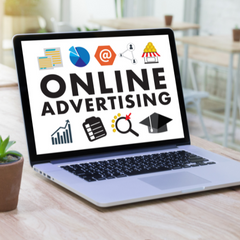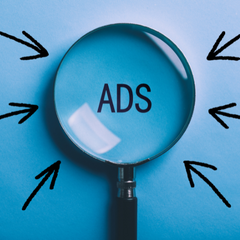
Ever wonder why some ads seem to work like magic, raking in sales and conversions, while others fizzle out with hardly any notice?
The secret lies in the art and science of ad copywriting.
Ad copy is not just about writing; it's about writing to persuade, convince, and convert.
In today’s digital age, where the average consumer is bombarded with thousands of ads daily, standing out is more crucial than ever.
This blog will help your ads stand out & convert like crazy by handing you eight battle-tested ad copywriting tips from legendary copywriters. Proven, practical strategies used by some of the best in the business to skyrocket your sales.
If you apply these tips in your copywriting, you will notice an immediate bump in engagement, clicks and sales.
But first…
What is Advertising Copywriting?

Advertising copywriting is the craft of writing promotional materials to persuade people to take some form of action, typically to buy a product or service.
But it’s not just any writing.
I’s a blend of art and psychology, designed to tap into your reader’s desires and needs.
The goal?
To move them from mere interest to definite action using the power of words.
Effective ad copywriting doesn’t just inform; it transforms prospects into buyers by appealing to their emotions, solving their problems, and offering them irresistible reasons to choose your product over others.
This involves a deep understanding of your target audience, what drives them, and how your product can fit into their lives not just as another item, but as a must-have solution.
From crafting the perfect headline that grabs attention to developing a compelling narrative that guides readers through a seamless journey of discovery and desire, advertising copywriting is about creating an experience that compels action. Whether it’s a social media ad, an email campaign, or a billboard, each piece of copy is a cog in a larger machine, designed to generate leads, drive sales, and ultimately contribute to a business's growth.
So, as we swim deeper into the nitty-gritty of what makes for killer ad copy, remember, it’s not just about what you say, but how you say it that turns words on a page into revenue in the bank.
1. Provide Eye Relief

In Gary Halbert’s influential "Boron Letters," one of the key lessons he reveals is the concept of eye relief in ad copywriting.
Halbert explains that making your copy visually appealing and easy to read is just as important as the content itself.
The idea behind eye relief is to prevent your reader from feeling overwhelmed by the text, thereby reducing the likelihood of them losing interest or getting fatigued.
How do you accomplish this?
- Short paragraphs, sentences & words
- Attention-grabbing subheadings
- Bullet points
- Highlight key words/phrases
- Brackets & parenthesis in the middle of text [like this] or (like this)
- And, of course, ample white space to break up your text.
This not only makes your ad copy easier to read but also aids in better comprehension and retention of information.
For example, rather than presenting a dense block of text, spacing out sentences and using bullet points to highlight key benefits allows your reader to scan quickly and grasp the essential points effortlessly.
Applying Halbert’s concept of eye relief in your ad copywriting ensures that your message is not only heard but also seen in a way that is visually engaging and easy to navigate.
This approach helps you capture/hold your reader's attention all the way down to your close, so that you have more opportunities to drive leads/sales.
2. The Slippery Slide Concept

Joseph Sugarman, another titan in the field of advertising copywriting, introduces the "Slippery Slide" concept in his book, The Adweek Copywriting Handbook.
This concept is pivotal for understanding how to keep your readers engaged from start to finish.
Sugarman’s Slippery Slide emphasizes that each sentence in an ad copy should serve one primary purpose: to get the next sentence read.
Starting with the headline, which pulls the reader in, each subsequent sentence must be crafted carefully to maintain interest and build curiosity. The reader's journey through your copy should be effortless, like sliding down a slippery slide—once they start, they can't stop until they reach the end.
To create this slippery slide effect, Sugarman highlights two powerful techniques: curiosity and storytelling.
Curiosity can be invoked through open loops or questions that are answered later in your copy, compelling your reader to continue reading to close that loop.
Storytelling, on the other hand, involves weaving a narrative that readers can relate to, making them emotionally invested in the characters or the outcome, and eager to read through to the end.
Example:
If your opening sentence is a bold claim or a shocking statistic, the next sentence should provide a slight explanation, which then leads to a detailed feature of the product, and so on. Each part of the copy links smoothly to the next, keeping the reader moving down the slide without a moment's hesitation.
Implementing these techniques in your ad copywriting involves a detailed look at the flow and transition between sentences and sections, ensuring clarity, engagement, and a compelling buildup to your call to action.
By applying Sugarman's Slippery Slide with an emphasis on curiosity and storytelling, your ad copy becomes not just informative but irresistibly engaging.
3. Build Scarier Mice, Not Bigger Mousetraps

In Breakthrough Advertising, Eugene Schwartz teaches a counterintuitive yet powerful lesson: focus on building scarier mice, not bigger mousetraps.
This metaphor encapsulates Schwartz’s approach to effective advertising, which is all about intensifying the problem in the minds of your potential customers rather than solely focusing on the features of the solution you offer.
The concept is simple yet profound.
Schwartz argues that by making the problem seem more significant, urgent, and relatable, you create a heightened sense of need for your product or service.
When the 'mouse'—the problem—is scarier, the necessity for a 'mousetrap'—your solution—becomes undeniable.
This approach shifts the focus from the product itself to the consumer's pain points, thereby making the solution appear more compelling and necessary.
For instance:
If you're selling a cybersecurity solution, instead of just highlighting the features of your software, emphasize the catastrophic consequences of data breaches and the increasing sophistication of cyber threats. This makes the problem feel more immediate and terrifying, thereby making your solution not just nice to have, but a must-have.
Applying this principle in your ad copywriting involves painting a vivid picture of the problems your audience faces and then positioning your product or service as the undeniable solution.
This not only grabs attention but also drives home the value of what you’re offering, making the purchase decision almost a matter of survival.
4. Entering the Conversation in Your Reader’s Head
Robert Collier, in his influential "The Robert Collier Letter Book," emphasizes a pivotal strategy in copywriting: entering the conversation already going on in the reader's head. Collier teaches that the most effective copywriters don't start a new conversation; instead, they seamlessly join the one that the potential customer is already having with themselves.
This approach requires a deep understanding of your audience, including their fears, desires, problems, and the solutions they are secretly wishing for. By aligning your message with these inner dialogues, your copy becomes incredibly relevant and resonant. It feels personal and tailored, as if you’re speaking directly to the individual reader, addressing their specific needs and concerns.
For example:
If you're writing ad copy for a weight loss product, don't just talk about the product’s features. Dive into the emotional struggle your reader is likely experiencing — frustration over past diet failures, confusion about conflicting dietary advice, or anxiety about health problems related to weight. Start your copy by acknowledging these feelings, which immediately tells the reader, "I understand you."
By employing this technique in your ad copywriting, you make your copy not only catch your reader’s attention but also hold it.
You are not merely selling a product; you are offering a solution that feels designed just for them.
This not only increases the effectiveness of the ad but also builds a deeper connection between your brand and your customer.
5. The Takeaway Close

Dan Kennedy, in his renowned book "The Ultimate Sales Letter", introduces a compelling closing technique known as the "Takeaway Close".
This method is about creating a sense of scarcity and urgency, which can dramatically increase the effectiveness of your sales letter or ad copy.
Kennedy asserts that when you suggest that a product or service might not be for everyone, or that it's available only for a limited time, you invoke a psychological trigger that makes the offer more desirable.
The Takeaway Close works by reversing the usual sales dynamic.
Instead of pushing the product onto the consumer, you're pulling it back slightly, suggesting that the opportunity to purchase might not last. This can be particularly effective because it taps into the consumer's fear of missing out (FOMO). People tend to want what they think they can't have, or what they believe they might lose the opportunity to get.
For instance, in ad copywriting, you might say, "We’re only taking on three new clients this month to ensure personalized service. Are you one of them?" This not only highlights the exclusivity of the service but also puts the reader in a position where they have to act quickly or risk losing out.
Incorporating the Takeaway Close in your ad copy requires a delicate balance. It’s important to ensure that the offer genuinely appears exclusive and limited. Overuse or transparent manipulation can lead to skepticism and a loss of trust.
However, when done correctly, this technique can transform passive readers into eager buyers, ready to act before the chance slips away.
6. The 4 Best Types of Headlines
In Tested Advertising Methods, John Caples emphasizes the critical role of headlines in advertising, pointing out that an effective headline is the most crucial element of any ad.
His methodology focuses on capturing attention and driving response with methodically crafted headlines.
Caples identifies four types of headlines that have consistently proven to be the most effective in testing:
- Self-Interest Headlines: These directly address the reader's needs, wants, or problems. They are compelling because they promise a specific benefit or solution. For example, "Lose 10 Pounds in 10 Days - Without Starving Yourself!"
- News Headlines: These incorporate new developments or introductions, such as product launches. They work well because they convey something fresh and thus inherently attention-grabbing. An example might be, "Introducing the All-New Eco-Friendly Home Cleaner That Saves You Money!"
- Curiosity Headlines: While these should still be combined with a benefit, they primarily aim to arouse the reader's curiosity. However, Caples warns that curiosity alone isn’t enough unless it's closely tied to a real interest of the reader. An example could be, "What Your Insurance Agent Doesn’t Want You to Know."
- Question Headlines: These ask something that the reader can relate to or would like to see answered. They engage the reader's mind and draw them into the ad. For instance, "Do You Make These Mistakes in English?"
By employing these types of headlines, according to Caples, advertisers can dramatically increase their chances of catching the eye of potential customers.
For effective ad copywriting, it’s crucial to choose the type of headline that best matches your message, audience, and intended response.
Utilizing Caples’ tested methods ensures your headlines do more than capture attention—they drive the reader to take action, enhancing the overall effectiveness of your advertising efforts.
7. Short Copy vs. Long Copy

Claude Hopkins, in his influential book "Scientific Advertising," tackles the perennial debate between short copy and long copy in advertising.
Claude argues that the length of the copy should be as long as needed to convey a complete sales message—no longer, no shorter.
Hopkins explains that there's no fixed rule about the optimal length of ad copy. Instead, the decision should be based on what is necessary to educate and persuade your customer.
For simple, well-understood products, shorter copy may suffice because the reader already has a basic understanding of the product and its benefits.
However:
For new, innovative, or complex offerings that require a deeper explanation, longer copy can be critical. It allows space to address anticipations, objections, and competitive advantages thoroughly.
For example:
If you're introducing a revolutionary new technology, your ad copy needs to explain how it works, why it's different, and why the reader should care—tasks that typically cannot be accomplished in just a few sentences. In contrast, a straightforward product enhancement might only require a brief update to engage potential customers.
Hopkins's approach emphasizes tailoring the message length to the message's needs, ensuring that every word serves a purpose. This way, your copy neither bores your reader with unnecessary details nor leaves them confused with too little information.
Following this guideline ensures that your advertising copywriting is efficient, effective, and exactly as long as it needs to be to convert readers into customers.
8. Handle Objections like a Madman
David Ogilvy, a prolific copywriter during the Madmen era, stressed that one of the most crucial aspects of persuasive ad copywriting is the ability to foresee and counter potential objections that your prospect might have.
Ogilvy's advice centers on the notion that every product or service has potential flaws or aspects that might deter a customer.
Sooooo…
Effective ad copy must acknowledge these potential objections upfront and address them convincingly. This not only builds trust by showing that the brand understands and respects the consumer's concerns but also helps smooth the path to purchase by removing barriers.
For instance:
If a product is more expensive than the competition, the ad copy shouldn't shy away from this fact. Instead, it should justify the higher price by explaining the superior benefits, quality, and value the customer will receive, thereby aligning the cost with perceived value.
Ogilvy also recommended turning potential weaknesses into strengths.
For example, if a car is slow to accelerate, the ad might focus on its superior fuel efficiency and smooth ride, which are direct outcomes of the engineering choices that also result in slower acceleration. This approach not only addresses the objection but also reframes it in a positive light.
Using Ogilvy's strategies for objection handling into your ad copywriting involves careful consideration of what might prevent a customer from purchasing and directly addressing those concerns with clear, compelling arguments.
By effectively handling objections within the ad copy, you significantly increase the chances of converting a skeptical reader into a convinced customer.
Conclusion
Apply these 8 ad copywriting tips the next time you write an advertisement.
If you do, I almost guarantee you will notice an immediate boost in response.
Also…
Want daily copywriting tips to help you escape your depressing day job and embark on a wild, fun career as a thriving freelance copywriter? Enter your email below:
